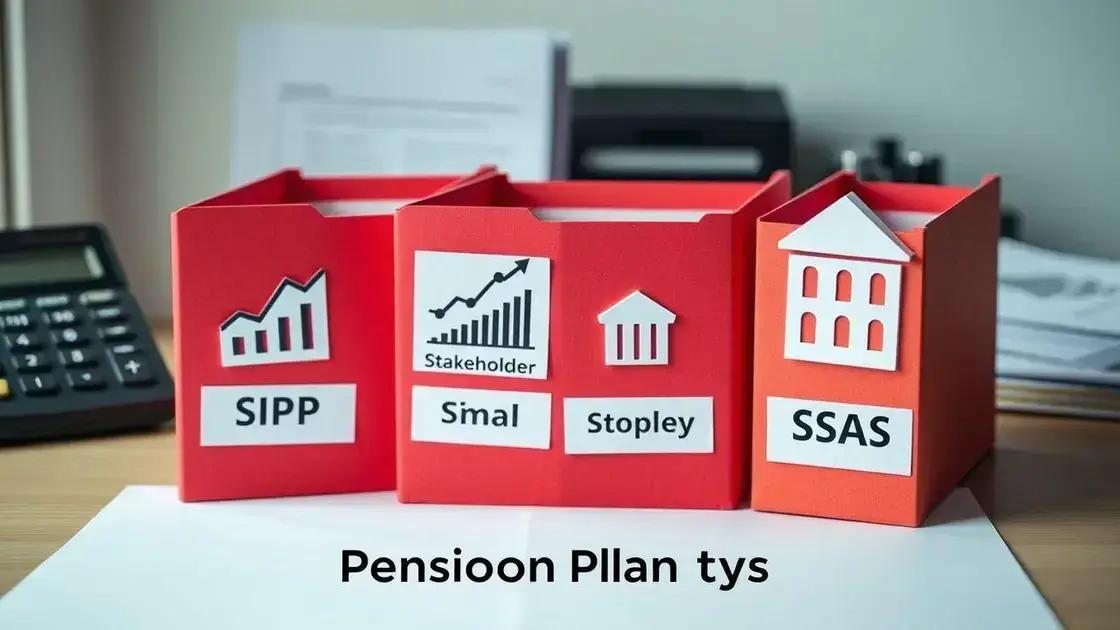Individual pension plan: why it’s the smartest move for your future

An individual pension plan could be your ticket to a stress-free retirement. Whether you’re self-employed or simply want more control over your savings, this plan offers flexibility and long-term security. Let’s break down how it works and why it might be the perfect fit for you.
What is an individual pension plan?
An individual pension plan (IPP) is a retirement savings strategy designed for self-employed individuals, business owners, or high-income earners who want more control over their retirement funds. Unlike traditional workplace pensions, an IPP allows you to customize contributions, investment choices, and retirement age to fit your financial goals.
How an IPP Works
With an IPP, you contribute funds into a tax-advantaged account that grows over time. These contributions are often tax-deductible, reducing your taxable income while building your retirement nest egg. The money is then invested in a mix of assets—such as stocks, bonds, and mutual funds—to grow until you retire.
Who Can Benefit?
This type of plan is ideal for those who don’t have access to employer-sponsored pensions or want to maximize their retirement savings beyond standard options like 401(k)s or IRAs. If you’re a freelancer, consultant, or small business owner, an IPP can offer higher contribution limits and greater flexibility.
One key advantage is that IPPs often allow for larger tax-deductible contributions compared to other retirement plans, making them a powerful tool for long-term wealth building. Additionally, some plans permit borrowing against the fund under specific conditions, providing financial flexibility if needed.
Key Features to Consider
Before setting up an IPP, it’s important to understand factors like contribution limits, investment rules, and withdrawal penalties. Consulting a financial advisor can help tailor the plan to your unique situation and ensure compliance with tax regulations.
Key benefits of an individual pension plan
An individual pension plan offers several unique advantages that make it stand out from other retirement options. One of the biggest benefits is tax efficiency – your contributions are typically tax-deductible, reducing your current taxable income while your investments grow tax-deferred until withdrawal.
Greater Control Over Investments
Unlike many employer-sponsored plans, an IPP lets you choose how your money is invested. You can select from a wider range of investment options to match your risk tolerance and retirement timeline. This flexibility can potentially lead to higher returns over the long term.
Higher Contribution Limits
For high earners and business owners, IPPs often allow significantly larger contributions compared to traditional retirement accounts. Some plans may let you contribute up to 3-4 times more than a standard 401(k), accelerating your retirement savings.
Another key advantage is the creditor protection many IPPs offer. In most cases, your pension assets are shielded from creditors, providing an extra layer of financial security. This can be particularly valuable for business owners or professionals in high-liability fields.
Customizable Retirement Age
With an IPP, you’re not locked into a standard retirement age. You can structure your plan to begin payouts when it makes the most sense for your situation, whether that’s earlier or later than the typical retirement age.
For business owners, there’s the added benefit of being able to make employer contributions to your plan. These contributions are often tax-deductible for the business while still growing tax-deferred for your retirement.
How does an individual pension plan work?
An individual pension plan (IPP) operates through a structured process that helps grow your retirement savings efficiently. First, you establish the plan with a financial institution or pension provider, choosing between different plan structures based on your needs.
Contribution Phase
During your working years, you make regular contributions to your IPP. These payments are typically tax-deductible, meaning they reduce your taxable income for the year. The money you contribute is then invested according to your selected strategy, growing tax-deferred until retirement.
Investment Growth
Your contributions are invested in a portfolio you choose – this might include stocks, bonds, mutual funds, or other approved investments. Unlike some retirement accounts, IPPs often allow for more aggressive investment strategies if desired, potentially leading to greater growth over time.
Retirement Phase
When you reach retirement age (which you often can specify in your plan), you begin receiving pension payments. These distributions are taxed as ordinary income, but typically at a lower rate since many retirees fall into a lower tax bracket. Some plans offer flexibility in how you receive payments – either as a lump sum or regular installments.
An important feature is that IPPs are creditor-protected in most jurisdictions, meaning your retirement savings are generally safe from legal claims or bankruptcy proceedings. The plan remains in effect until all funds are distributed or transferred to another retirement vehicle.
Who should consider an individual pension plan?
An individual pension plan is particularly beneficial for specific groups of people who need more robust retirement solutions. Self-employed professionals and small business owners often find IPPs ideal, as they typically don’t have access to employer-sponsored retirement plans.
High-Income Earners
If you’re in a high tax bracket, an IPP can provide significant tax advantages. The ability to make larger, tax-deductible contributions makes it an attractive option for doctors, lawyers, executives, and other professionals with above-average incomes.
Late Starters to Retirement Planning
For those who began saving for retirement later in their careers, an IPP’s higher contribution limits can help accelerate savings growth to catch up. The tax-deferred growth helps maximize every dollar you put away.
Business owners with consistent profits should consider IPPs, as they allow for both employee and employer contributions. This dual contribution structure can significantly boost retirement savings while providing business tax deductions.
Those Seeking Creditor Protection
Professionals in fields with higher liability risks (like physicians or contractors) may benefit from the asset protection features of IPPs. In most cases, these plans offer protection from creditors that standard investment accounts don’t provide.
Even if you already have a workplace retirement plan, an IPP can serve as a valuable supplement if you’ve maxed out your other retirement account contributions and want to save more for your golden years.
Types of individual pension plans available

When considering an individual pension plan, you’ll encounter several distinct types, each with unique features. Defined contribution plans are among the most common, where your retirement benefits depend on how much you contribute and how those investments perform over time.
Self-Invested Personal Pensions (SIPPs)
SIPPs offer the broadest investment choices, allowing you to invest in stocks, bonds, commercial property, and other assets. They provide maximum control for savvy investors who want to manage their own retirement portfolio.
Stakeholder Pensions
These are simpler, low-cost options with capped charges and minimum contribution requirements. Stakeholder pensions are ideal for those who prefer a hands-off approach to retirement planning with limited investment choices.
For business owners, Small Self-Administered Schemes (SSAS) provide unique advantages. These allow investment in business premises and loans back to the company, combining retirement planning with business financing opportunities.
Personal Pension Plans
Traditional personal pensions offer a middle ground with a range of investment funds managed by professionals. They typically provide automatic lifestyling – gradually shifting to lower-risk investments as you approach retirement age.
Newer options like flexible drawdown plans allow you to take lump sums while keeping the remainder invested, offering more control over how and when you access your retirement funds.
How to set up your individual pension plan
Setting up an individual pension plan involves several key steps that ensure you create the right plan for your retirement goals. First, assess your financial situation – determine how much you can contribute regularly and when you plan to retire.
Choosing the Right Provider
Research different pension providers to compare fees, investment options, and flexibility. Look for providers with strong track records and transparent pricing structures. Many financial institutions and specialized pension companies offer IPP products.
Completing the Application
The application process typically requires personal details, employment information, and your National Insurance number. You’ll need to decide on contribution amounts and frequency – whether monthly, quarterly, or lump sum payments.
One crucial step is selecting your investments. Most providers offer a range of funds with different risk levels. Consider diversifying across asset classes and possibly including ethical investment options if that aligns with your values.
Ongoing Management
After setup, regularly review your plan’s performance. Many providers offer online portals where you can monitor growth, adjust contributions, and rebalance investments as needed. Consider setting up automatic contributions to maintain consistent savings.
Remember to keep all documentation and stay informed about any tax changes that might affect your pension. Many find it helpful to consult a financial advisor during setup to ensure all aspects are properly configured for their specific situation.
Tax advantages of an individual pension plan
One of the most compelling reasons to consider an individual pension plan is the significant tax benefits it offers. Contributions you make to your IPP are typically tax-deductible, meaning they reduce your taxable income for the year in which you make them.
Tax Relief on Contributions
For every contribution you make, you effectively get tax relief at your highest marginal rate. If you’re a higher-rate taxpayer, this means you could get 40% or more back through tax savings – the government essentially contributes to your retirement fund through these tax breaks.
Tax-Free Growth
All investment growth within your pension plan accumulates free from capital gains tax and income tax. This tax-deferred compounding can significantly boost your retirement savings compared to taxable investment accounts.
When you reach retirement age, you can typically take up to 25% of your pension pot as a tax-free lump sum. The remaining balance used to provide retirement income is taxed as earned income, but often at lower rates since many retirees fall into lower tax brackets.
Inheritance Tax Benefits
Pensions generally sit outside your estate for inheritance tax purposes. With proper planning, you can potentially pass on your pension wealth to beneficiaries with favorable tax treatment, making IPPs an efficient wealth preservation tool.
For business owners, employer contributions to staff pensions (including your own) are typically allowable business expenses, reducing corporation tax liabilities while building valuable retirement benefits.
Common mistakes to avoid with your plan
When managing an individual pension plan, several common pitfalls can undermine your retirement strategy. One major mistake is under-contributing – many people don’t take full advantage of their plan’s contribution limits, missing out on valuable tax benefits and compounding growth.
Poor Investment Diversification
Putting all your pension funds into one type of investment exposes you to unnecessary risk. A properly diversified portfolio across different asset classes helps protect your savings from market volatility while maintaining growth potential.
Ignoring Fees and Charges
High management fees can significantly erode your pension pot over time. Many investors fail to regularly review their plan’s fee structure and compare it with other available options that might offer better value.
Another frequent error is not updating beneficiary details after major life events like marriage, divorce, or having children. This oversight could mean your pension doesn’t go to your intended recipients.
Early Withdrawal Temptations
Accessing pension funds before retirement often comes with heavy penalties and tax consequences. Many people don’t realize how much this can set back their long-term financial security.
Finally, a critical mistake is setting and forgetting your plan. Regular reviews (at least annually) are essential to adjust contributions, rebalance investments, and ensure your strategy aligns with changing life circumstances and retirement goals.
Comparing individual pension plans to other retirement options
When evaluating retirement options, understanding how an individual pension plan compares to alternatives is crucial. Unlike workplace pensions, IPPs offer greater contribution flexibility and investment control, making them ideal for self-employed individuals and high earners.
IPPs vs. Workplace Pensions
While workplace pensions benefit from employer contributions, IPPs typically allow higher personal contributions and more investment choices. They’re particularly valuable when employer pension options are limited or when you’ve maximized workplace plan contributions.
IPPs vs. ISAs
Unlike ISAs where contributions are made from taxed income but withdrawals are tax-free, IPPs provide upfront tax relief but tax withdrawals in retirement. IPPs generally offer better long-term growth potential for retirement savings due to their tax-deferred compounding.
Compared to property investments, IPPs provide diversification without liquidity risks and don’t require active management. They also offer creditor protection that property investments typically lack.
IPPs vs. General Investments
Standard investment accounts don’t offer the same tax advantages as IPPs. The tax relief on contributions and tax-deferred growth make IPPs significantly more efficient for retirement-specific savings, though they come with access restrictions until retirement age.
For business owners, IPPs can be more advantageous than director’s loans or retained profits as a wealth extraction strategy, combining tax efficiency with retirement planning benefits.
How much should you contribute to your plan?

Determining how much to contribute to your individual pension plan depends on several personal factors. A good starting point is the 50-30-20 rule – allocating 20% of your income to savings, with a significant portion going to your pension. However, your ideal contribution should reflect your age, income, retirement goals, and current financial obligations.
Age-Based Contribution Strategies
If you’re starting young (20s-30s), contributing 10-15% of your income may be sufficient due to compound growth. Those beginning in their 40s-50s should aim for 20-25% or more to catch up. Remember, IPPs often allow higher contributions than standard retirement accounts.
Income Considerations
High earners should maximize their contributions to benefit from tax relief, especially if they’re in higher tax brackets. The general guideline is to contribute enough to maintain your desired lifestyle in retirement – typically 70-80% of your pre-retirement income.
Don’t overlook employer matching if available – this is essentially free money toward your retirement. Even if you’re self-employed, consider making both employee and employer contributions to maximize tax advantages.
Adjusting Over Time
Your contribution rate isn’t set in stone. Increase contributions with salary raises, windfalls, or when other financial obligations decrease. Many experts recommend increasing contributions by 1% annually until you reach your target percentage.
Use online pension calculators as a starting point, but consider consulting a financial advisor for personalized advice tailored to your specific retirement goals and financial situation.
Reviewing and adjusting your individual pension plan over time
Regularly reviewing your individual pension plan is crucial to ensure it continues to meet your evolving retirement goals. Financial experts recommend conducting a comprehensive review at least annually, with more frequent check-ins when major life events occur or market conditions change significantly.
Performance Evaluation
Assess your plan’s investment performance against relevant benchmarks and your personal targets. Don’t just look at short-term fluctuations – focus on long-term trends and whether your portfolio remains aligned with your risk tolerance and time horizon until retirement.
Life Event Adjustments
Major life changes like marriage, divorce, having children, career shifts, or inheritance should trigger a plan review. These events may necessitate adjusting your contribution levels, risk profile, or even your planned retirement age.
As you approach retirement (within 5-10 years), consider gradually de-risking your portfolio by shifting some growth assets to more stable investments. This helps protect your accumulated savings from significant market downturns right before you need to access them.
Legislation and Tax Changes
Stay informed about pension legislation updates and tax law changes that might affect your plan. What made sense when you first set up your IPP might not be optimal under new rules. A financial advisor can help navigate these complexities.
Remember that your pension plan should evolve as you do. Regular reviews ensure you’re making the most of contribution opportunities, tax benefits, and investment strategies appropriate for your current life stage and future aspirations.
Securing Your Financial Future with an Individual Pension Plan
An individual pension plan offers a powerful way to take control of your retirement savings, providing flexibility, tax advantages, and investment choices tailored to your unique needs.
Whether you’re self-employed, a high earner, or simply want more retirement options, an IPP can help bridge the gap between your current finances and the retirement lifestyle you envision.
Remember that starting early, contributing consistently, and regularly reviewing your plan are key to maximizing its benefits. While retirement may seem far away, the decisions you make today will significantly impact your financial security tomorrow.
Consider consulting a financial advisor to help customize an IPP strategy that aligns with your goals, and take that important first step toward building the retirement you deserve.






